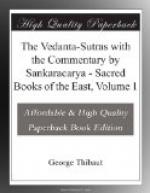Notes:
[Footnote 1: The only ‘sectarian’ feature of the Sri-bhashya is, that identifies Brahman with Vish/n/u or Naraya/n/a; but this in no way affects the interpretations put on the Sutras and Upanishads. Naraya/n/a is in fact nothing but another name of Brahman.]
[Footnote 2: The Roman numerals indicate the number of the adhikara/n/a; the figures in parentheses state the Sutras comprised in each adhikara/n/a.]
[Footnote 3: Deussen’s supposition (pp. 30, 150) that the passage conveying the second interpretation is an interpolation is liable to two objections. In the first place, the passage is accepted and explained by all commentators; in the second place, Sa@nkara in the passage immediately preceding Sutra 12 quotes the adhikara/n/a ’anandamayo s bhyasat’ as giving rise to a discussion whether the param or the aparam brahman is meant. Now this latter point is not touched upon at all in that part of the bhashya which sets forth the former explanation, but only in the subsequent passage, which refutes the former and advocates the latter interpretation.]
[Footnote 4: Eva/m/ jij/n/anasya brahma/nas/ kotanabhogvabhutaga/d/arupsattvara, istamomayapradhanad vyav/ri/ttir ukta, idani/m/ karmava/s/vat trigu/n/atmakaprik/ri/u sa/m/sangammittanamavidhan intadukhasagaranimajjaoni/s/addha/h/. ki pratya gaumano nyan nikhilaheyapratauika/m/ miatimyanandam brahmeti pratipadyate, anandamayo bhyasat.]
[Footnote 5: There is no reason to consider the passage ‘atra ke/k/it’ in Sa@nkara’s bhashya on Sutra 23 an interpolation as Deussen does (p. 30). It simply contains a criticism passed by Sa@nkara on other commentators.]
[Footnote 6: To the passages on pp. 150 and 153 of the Sanskrit text, which Deussen thinks to be interpolations, there likewise applies the remark made in the preceding note.]
[Footnote 7: Givaysa iva parasyapi brahma/n/a/h/ sarirantarvaititvam abhyupagata/m/ ket tadvad eva sarirasainbandhaprayuktasukhadukhopabhogapraptir hi ken na, hetuvai/s/eshyat, na hi sarirantarvartitvam eva sukhadukhopabhogahetu/h/ api tu pu/n/yapaparnpakarmaparavasatva/m/ ta/k/ Kapahatapapmana/h/ parahatmano na sambhavati.]




